-

《百合花》说课稿 2021-2022学年统编版高中语文必修上册
1. 厘清全文的线索、情节,体会小说结构严谨、清新俊逸的写作风格。2. 分析通讯员、新媳妇的人物形象,通过品味生动的细节来感知人物身上洋溢的人性美、青春美。3.通过自主、合作、探究,从不同角度和层面发掘“百合花”这一主题的独特意蕴。4.通过把握小说人性美、青春美的主题,引导学生提升自身的精神品质和道德情操。教学重点是:通讯员及新媳妇的性格特征分析,小说如何通过细节描写来塑造人物性格。教学难点是:从不同角度和层面发掘“百合花”这一主题的独特意蕴。【教学方法】本文篇幅较长,但我们决定用一个课时来完成教学任务,课前让学生充分预习文本,自己搜集有关“百合花”的知识资料,自主梳理文章的故事情节,自主归纳人物的形象、性格特点。课堂上采用情景激趣法、启发诱导法、合作探究法等教学方法来引导学生学习探究,培养学生的文学鉴赏能力。

《梦游天姥吟留别》说课稿 2022—2023学年统编版高中语文必修上册
【说教材】《梦游天姥吟留别》是部编版必修上册第三单元的一篇古诗词。这个单元以生命的诗意为主题,汇集了不同时期、不同体式的诗词名作。本诗的作者李白是浪漫主义诗人的代表,他以瑰丽的想象,在这首诗中为我们塑造了一个迷离的梦境。整首诗以七言为主,但不拘格律限制,行笔恣意洒脱,寄寓了自己深沉的身世之感【说学情】初中语文的古诗词教学侧重识记背诵,学生具备了一些文体知识,但还缺乏对古典诗歌进行系统性鉴赏的能力,进入高中阶段,需要指导学生在理解文本表层含义的基础上,深入解读诗歌、表达自己的见解。【说教学目标】根据语文学科素养的要求,我确立了这四个教学目标。语言方面,要能熟读内容,结合注释疏通文意,把握文中的关键字、词、句的含义。思维方面,缘景明情,在诵读过程中分析、感悟诗歌内容。审美鉴赏与创造方面,要能鉴赏梦游的意境,体会李白的浪漫主义诗风,提高鉴赏能力;文化方面,要能够品味诗人情感,感受其追求自由、不慕名利的高尚人格。
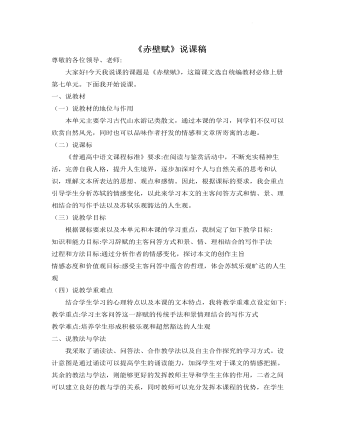
《赤壁赋》说课稿 2021-2022学年统编版高中语文必修上册
(三)赏析课文,品味哲理此环节重在解决本课的重点难点。首先,我运用问答法解决1.2两个问题。问答可以吸引学生注意,激发学生思维,培养学生概括和说话能力。通过学生的回答,即“固一世之雄也,而今安在哉”和“哀吾生之须臾,羡长江之无穷”以及“挟飞仙以遨游,抱明月而长终”这三个句子,最后明确答案:古今历史对比生悲、人生短暂和自然无穷对比生悲、理想与现实矛盾生悲;再以同样的方式分析第4段,通过教师提出问题,学生进行思考和回答这一过程,归纳出“水与月”、“变与不变”和“自然之无尽藏也”这三层哲理,最后得出是苏轼超然洒脱、乐观旷达的人生观劝慰了客人,从而达到第5段中“客喜而笑”的结果。设计两个问题的意图是让学生得以把握苏轼由疑惑沮丧到豁然开朗这一情感变化,从而更好的赏析本文。
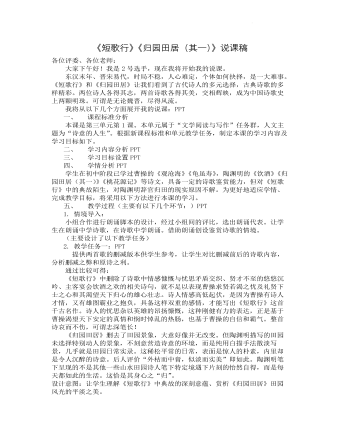
《短歌行》《归园田居》说课稿 2021-2022学年统编版高中语文必修上册
3. 教学任务二:PPT子任务一、二、三感悟诗情:那么为什么不能轻易对诗人诗歌进行删减呢?除了诗歌语言及内容方面的影响外,还有重要的一点就是:感情。情感是诗歌的尺度,而非长短。下面将从知人论世的角度再读诗歌。重点赏析曹操的“忧”与“解”和陶渊明的“误”与“归”。通过编写诗人年谱的方式,呈现诗人的各个人生阶段的经历和当时的时代背景,让诗人回到历史现场,让自己代入诗人境遇,以意逆志。通过查阅资料和编写年谱,可以了解到:曹操既能横槊,又能赋诗,如曹丕在《典论·自叙》中所说:“上(曹操)雅好诗文书籍,虽在军旅,手不释卷。”《短歌行》中多用典故和善用比兴或许就源于此。其次,曹操虽出身仕宦,但门第不算高贵,这样的家庭地位让他有着出人头地、建功立业的迫切愿望,因此,“唯才是举”是曹操出于现实的理性选择。再次,曹操写《短歌行》的确切时间已难考证,如取赤壁大战前的说法,曹操已五十四岁,来日无多的紧迫感、贤才归附的愿望自然尤为强烈。
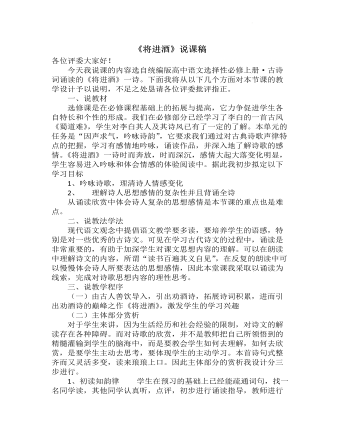
古诗词诵读《将进酒》说课稿2021-2022学年高中语文统编版选择性必修上册
一、说教材选修课是在必修课程基础上的拓展与提高,它力争促进学生各自特长和个性的形成。我们在必修部分已经学习了李白的一首古风《蜀道难》,学生对李白其人及其诗风已有了一定的了解。本单元的任务是“因声求气,吟咏诗韵”,它要求我们通过对古典诗歌声律特点的把握,学习有感情地吟咏,诵读作品,并深入地了解诗歌的感情。《将进酒》一诗时而奔放,时而深沉,感情大起大落变化明显,学生容易进入吟咏和体会情感的体验阅读中。二、说教法学法现代语文观念中提倡语文教学要多读,要培养学生的语感,特别是对一些优秀的古诗文。可见在学习古代诗文的过程中,诵读是非常重要的,有助于加深学生对课文思想内容的理解。可以在朗读中理解诗文的内容,所谓“读书百遍其义自见”,在反复的朗读中可以慢慢体会诗人所要表达的思想感情,因此本堂课我采取以诵读为线索,完成对诗歌思想内容的理性思考。
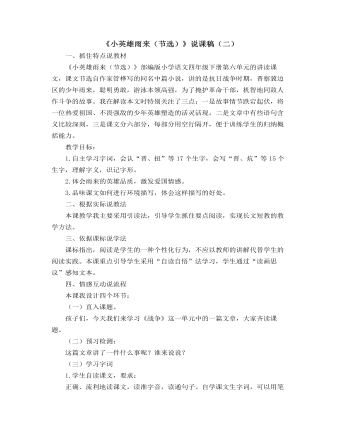
部编人教版四年级下册《小英雄雨来》说课稿(二)
一、抓住特点说教材《小英雄雨来(节选)》部编版小学语文四年级下册第六单元的讲读课文,课文节选自作家管桦写的同名中篇小说,讲的是抗日战争时期,晋察冀边区的少年雨来,聪明勇敢,游泳本领高强,为了掩护革命干部,机智地同敌人作斗争的故事。我在解读本文时特别关注了三点:一是故事情节跌宕起伏,将一位热爱祖国、不畏强敌的少年英雄塑造的活灵活现。二是文章中有些语句含义比较深刻,三是课文分六部分,每部分用空行隔开,便于训练学生的归纳概括能力。教学目标:1.自主学习字词,会认“晋、扭”等17个生字,会写“晋、炕”等15个生字,理解字义,识记字形。2.体会雨来的英雄品质,激发爱国情感。3.品味课文如何进行环境描写,体会这样描写的好处。
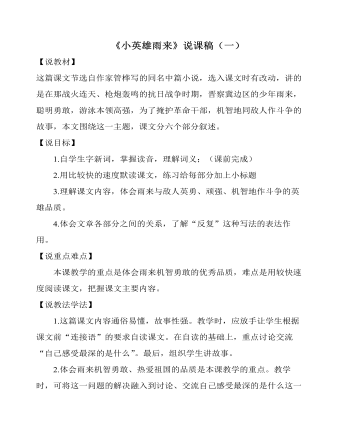
部编人教版四年级下册《小英雄雨来》说课稿(一)
【说教材】这篇课文节选自作家管桦写的同名中篇小说,选入课文时有改动,讲的是在那战火连天、枪炮轰鸣的抗日战争时期,晋察冀边区的少年雨来,聪明勇敢,游泳本领高强,为了掩护革命干部,机智地同敌人作斗争的故事,本文围绕这一主题,课文分六个部分叙述。【说目标】1.自学生字新词,掌握读音,理解词义;(课前完成)2.用比较快的速度默读课文,练习给每部分加上小标题3.理解课文内容,体会雨来与敌人英勇、顽强、机智地作斗争的英雄品质。
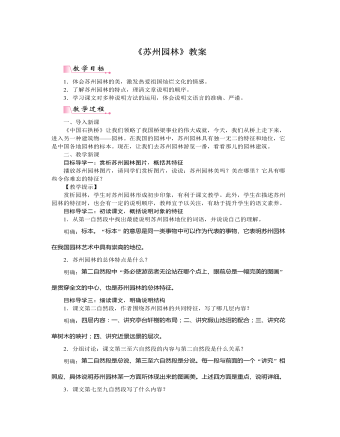
部编版语文八年级上册《苏州园林》教案
(1)作比较。“我国的建筑,从古代的宫殿到近代的一般住房,绝大部分是对称的……苏州园林可绝不讲究对称。”(作用:将苏州园林的建筑不对称性与其他建筑的对称性作比较,更加突出苏州园林的美术画特点。)(2)举例子。“有几个园里有古老的藤萝,盘曲嶙峋的枝干就是一幅好画。”(作用:以几个园里的古藤为例,生动形象地说明苏州园林栽种和修剪树木着眼于画意。)(3)列数字。“苏州园林据说有一百多处,我到过的不过十多处。”(作用:作者实事求是,不以一“多”字作搪塞,事实上,“一百多处”是出于作者已知条件下对园林数字的准确概括,“十多处”是作者写此文章的依据。)(4)摹状貌。“高树与低树俯仰生姿。落叶树与常绿树相间。”(作用:使说明对象更具有形象性。)总结:课文综合运用多种说明方法,使文章显得不单调,同时又使得文章的介绍清晰明了。
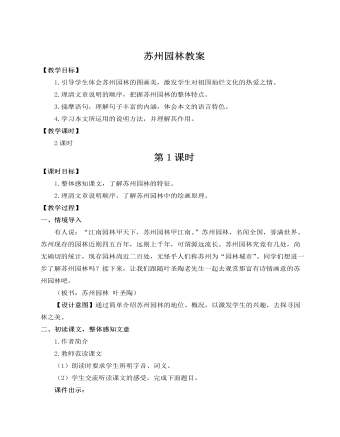
人教部编版语文八年级上册苏州园林教案
1.南方园林江南有温和的气候、充沛的水量、丰盛的物产、优美的景色、宽松的人文环境,其园林营建必然自呈特色。《中国大百科全书·江南园林》将其总结为三点:第一,叠石理水、水石相映。太湖石奇特多姿,在庭中造型尤佳。最称绝的是苏州瑞云峰、杭州植物园绉云峰、上海豫园玉玲珑。第二,花木种类多。第三,建筑风格淡雅、朴素。布局自由,结构不拘定式,清新洒脱,小巧细腻,幽雅美丽。小阁临流,冷色多,像山水画。青瓦素墙,褐色门窗,官僚政治意识淡薄,书卷气深浓。南方园林以江南园林为代表。江南园林主要指以苏州、杭州、无锡、扬州、南京、上海、常熟等城市为主的私家园林。江南园林属于文人写意派山水园,文人画家参与造园,以人工造景为主,规划巧妙,设计精致,人文气氛浓。造园师在有限的空间再现真实的自然山水,以小见大,意蕴无穷。
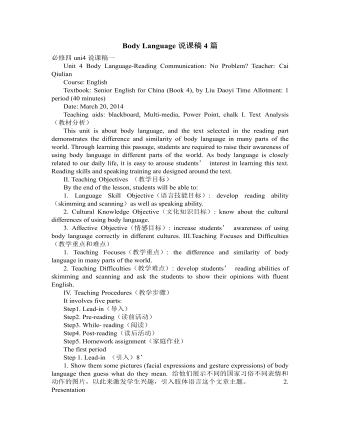
人教版高中英语必修4Body Language说课稿4篇
Textbook: Senior English for China (Book 4), by Liu Daoyi Time Allotment: 1 period (40 minutes)Date: March 20, 2014Teaching aids: blackboard, Multi-media, Power Point, chalk I. Text Analysis (教材分析)This unit is about body language, and the text selected in the reading part demonstrates the difference and similarity of body language in many parts of the world. Through learning this passage, students are required to raise their awareness of using body language in different parts of the world. As body language is closely related to our daily life, it is easy to arouse students’ interest in learning this text. Reading skills and speaking training are designed around the text.II. Teaching Objectives (教学目标)By the end of the lesson, students will be able to:1. Language Skill Objective(语言技能目标): develop reading ability (skimming and scanning)as well as speaking ability.2. Cultural Knowledge Objective(文化知识目标): know about the cultural differences of using body language.3. Affective Objective(情感目标): increase students’ awareness of using body language correctly in different cultures. III.Teaching Focuses and Difficulties(教学重点和难点)1. Teaching Focuses(教学重点): the difference and similarity of body language in many parts of the world.2. Teaching Difficulties(教学难点): develop students’ reading abilities of skimming and scanning and ask the students to show their opinions with fluent English.
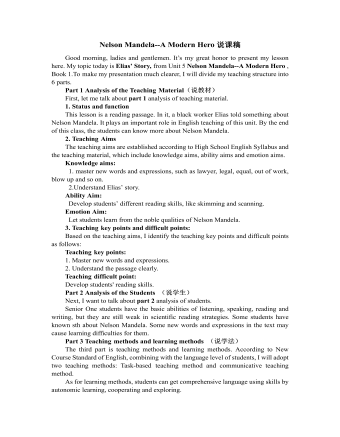
人教版高中英语必修1Nelson Mandela--A Modern Hero说课稿
In this step, give students a few minutes to read the passage . While they are reading, I will write some key words of the text on the blackboard. Then ask students to retell the passage according to the key words.By retelling, students can improve their ability of language organization and have an overall understanding of the article.Step 4 Group discussionIn this step, students will be divided into groups of 4 to discussion the following question: What qualities make a great person?After their discussion, invite a few groups to make a report to the class.This group discussion can practice students’ oral English and cultivate their abilities of cooperation and communication.Step 5. HomeworkLet students write a short passage to introduce a great person he or she admires.The homework can consolidate the knowledge the students have learned and cultivate their writing ability. Part 6 Blackboard Design(板书设计)That’s all my teaching procedures. Finally, I’d like to say sth about part 6 blackboard design. On the top is the title. On the left, there will be some new words and expressions. In the middle of the blackboard, I will write some useful sentence structures so that the students can know clearly what they’ve learned and then try to master the knowledge.OK. That’s all for my presentation. Thank you for your attention.
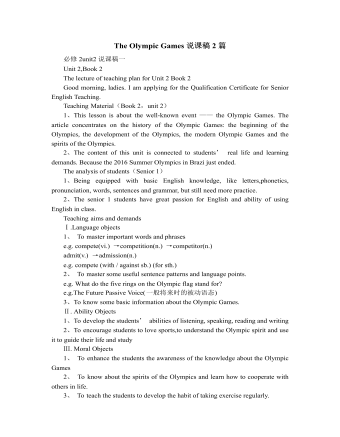
人教版高中英语必修2The Olympic Games说课稿2篇
Purpose of my design:To ask the students to do these two tasks will make the Ss predict the story of this passage. As a result, it will deepen Ss’ memory of this story because they will have their own understanding of this story.Step 3. While-readingTask 1. (Individual work _____min)Skimming: ask students to skim the text and the main ideas of each paragraph in this passage. Please read it quickly and then match the sentences with the letters.Task 2. (Individual work _____min)Scanning: read the text quickly and decide the whether the following statements are true or false and give reasons.Task 3. (Pair work _____min)Listen to the tape and fill in the banks. Then read the paragraph with expression to your partner.Task4 (individual work min)Listen to the tape again and write down the main idea in one sentence.Purpose of my design: Enable students to understand the given material better by using different reading skills. And proper competition can arouse the Ss’ interest in English learning. “Task-based” teaching method is used here todevelop the Ss’ ability of communication and also their ability of co-operation will be well trainedStep 4. Post-readingTask 1. (Individual work, pair work, group work, class work; _____min)Discussion (group of 4):1. If you were Hippomenes, would you run against Atlanta?2. Do you think Hippomenes deserved to win the race? Why or why not?Step 5. HomeworkPlease read the story again carefully after class and imagine: What will happen during the race between Hippomenes and Atlanta? Who do you think will win the race? Do you think Atlanta would marry Hippomenes? Write an end for the story with thses questions.Purpose of my design: Homework is so important and necessary for to master the knowledge they learned after class. It will check whether the Ss achieve the teaching aims.Part 5 Blackboard design
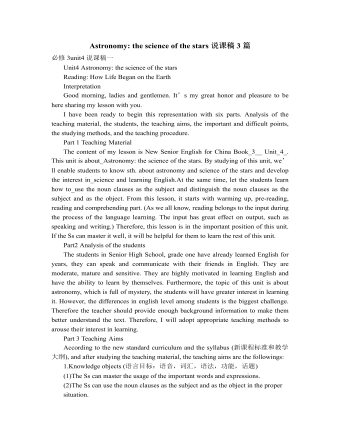
人教版高中英语必修3Astronomy the science of the stars说课稿3篇
Step 2 Pre-listeningAfter students finish their discussion, I will show a picture of Newton and ask them: Who is him? What is he famous for? Could you find out some words to describe him? Maybe students will answer that he is genius for his finding of theGravitation, making a great contribution to the progress of human being. At that time I will show another two pictures of Einstein and Hawking, letting students guess who they are and write down their idea about the Gravitation. For I have arranged them to search more information about the gravity before this class, Students have beenfamiliar with the topic and will not be afraid about this abstract conception, which is helpful for their listening.Step 3 While-listeningIn this step, students will be required to listen the material for three times. The first and listening is extensive listening and the second and third listening is intensive listening. In the first time, They are required to listen a material including Part 1 and Part 2 and choose the best summary of the listening text. After they choose the right answer, They also need work in group to explain what is wrong with the others. Then I will make a conclusion that we should pay attention to the first paragraph and last paragraph and some keys to get the main idea. By doing this, their capacity of generalization will have a great improvement.Before the second listening, I will ask students to scan the blank on the power point quickly and ask them to note down some key words .Then ask them to listen to the Part 1again and fill the first column of the chart. Maybe some students just show the ideas of these three scientists an still can’t catch their development of gravity. Therefore, I will ask them to listen to Part 2 again and fill in the rest. After finish the listening, I will give them ten minutes to discuss with their partner. I will also guidethem to improve their answers when they discuss with others.
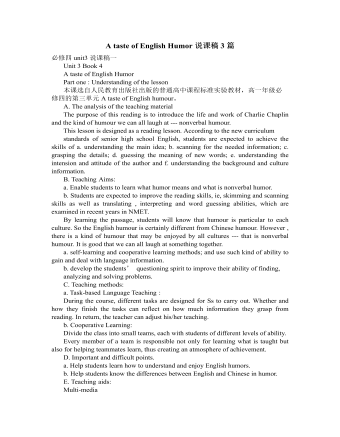
人教版高中英语必修4A taste of English Humor说课稿3篇
Then I would ask them to think of a funny English or Chinese and tell it to partners. While telling stories, they can use expressions and some acting to help make the story funny. 5 minutes would be given to do this.Those stories they told there will be the material for their writing. Soletting them tell it at first is helpful. And they can make a difference between telling a funny story and writing it down. Generally speaking, it is difficult forstudents to write well because they don’t know what to write and how to write. Asking them to tell their own stories at first can help them come up with what to write.After their telling, I would invite someone to share his/her story with all of us and I would write it down on the blackboard.This example story would be used as a sample to illustrate the format of funny story. Different from a story from teacher or textbook, a story from students can obviously become a interesting material to draw students’ attention.Then I would ask the whole class to put this story into several parts. It might be a little bit difficult for them. So I would ask them to find out whether all the sentences are necessary. After delete some sentences, there are 6 sentences left behind. Then they can easily put them into three parts. After interaction with students, I would teach them the right terms for each part and conclude the format of funny story.This step is the key and difficult point in my lesson. So I mainly usetask-based teaching method in this part and the task for students was divided into several stages. With the separated difficult level, students can find there are usually three parts in writing. They can also learn to write without the unnecessary parts in the process of analyzing. And then I wouldn’t rush to tell them the right terms to them directly. Instead, I would ask them to name them by their own. A confused mind is better for acquiring knowledge.While-writing:Then I would give students 7 minutes to write down this story, without other requirements.With all the preparations in pre-writing, students’ difficulties were cleared. So it would be much easier for them to write down the story within 7 minutes. There are no other requirements because students’ first writing is actually a drafting. It would be revise and edit several times later. Writing, as a skill
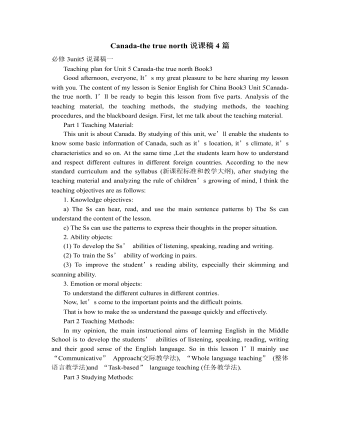
人教版高中英语必修3Canada-the true north说课稿4篇
Good afternoon, teachers, It’s my great pleasure to be here sharing my lesson with you.The content of my lesson is Senior English Book 3 Unit 5 Canada —— “The true North”.I’ll be ready to begin this lesson from five parts. Analysis of the teaching material,the teaching methods,the studying methods, the teaching procedure,and Blackboard design.First, let me talk about the teaching material.Part 1 Teaching Material:This unit is about the introduction of Canada. By studying of this unit,we’ll enable the students to learn the geography, population, main cities, and natural beauty, natural resources of Canada. Through the training of the unit, it also requires students to learn some Language skills such as the expressions of position and emotions.So it plays an important part in the English teaching in this book.After studying the teaching material and analyzing the rule of children’s growing of mind,I think the teaching aims are the followings:1.Knowledge objects:(1) make the students learn some new words and phrases(2) make the students understand the content of the lesson.2.Ability objects:(1)To develop the Ss’ abilities of listening, speaking, reading and writing. Especially reading and speaking ability.(2) learn to talk about the characters of Canada in English(3)To train the Ss’ ability of working in pairs.3.Emotion objects:(1)Enable students to understand the characters of Canada..(2)Stimulate Ss to work hard to make China stronger.Part 2 Teaching Methods:I think helping students learn to master new words and phrases and improve the students’ reading and speaking ability is import and the difficult.According to the analysis of the teaching material and the import points and the difficult points,I will use the following teaching methods : question-guiding approach; fast-reading and careful reading; multi-media teaching methods; discussion
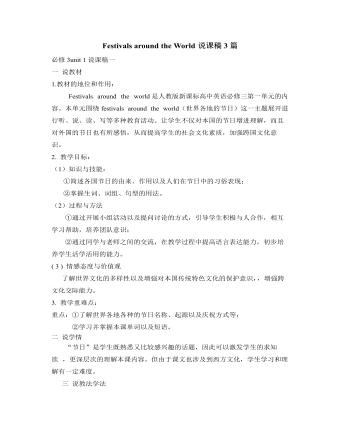
人教版高中英语必修3Festivals around the World说课稿3篇
Teaching plan for Unit 1 book3Good morning, teachers. It’s my great pleasure to be here because I can share my lesson with you and I can learn a lot from it. I’ll begin my lesson from the following four parts, the teaching material, the teaching methods, the studying methods and the teaching procedure.Firstly, let me talk about the teaching material. The content of my lesson is the reading passage festivals and celebrations of Unit 1 Festivals around the world. This passage is about festivals and celebrations. By studying this passage, we’ll enable the students to know that festivals exit everywhere, and many of festivals in different countries celebrate similar ideas. As we all know, the reading passage is the center of each unit. If the Ss can learn it well, it will be helpful to make the Ss learn the rest of this unit.After studying the teaching material, I think the teaching aims are as the followings:1. Knowledge aims:(1) The Ss can master the usage of the important words andexpressions.(2)The Ss can use the __________________ (grammar) in the proper situation.Make students know about the festivals all over the world and the detail of the festivals, such as origin, content, and the date of the holiday festivals.2. Ability aims:(1) Students can talk about festivals and celebrations in English(2) To improve the student’s reading ability, especially their skimming and scanning ability.3. Emotion aims:Make the Ss know about the foreign festivals, and respect other countries’ custom.Next, let’s come to the important points and the difficult points.The important point is how to make the Ss understand the text better and the difficult point is how can they talk about it. secondly, Teaching Methods:1. task-based Language Teaching2. Computer assisted language teaching.3. question-and–answer methodThirdly, Studying Methods:
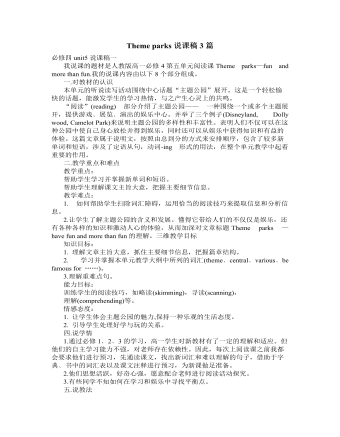
人教版高中英语必修4Theme parks说课稿3篇
The oldest and the most popular park in the worldenjoy the exciting activities thereget close to the life-size cartoon characters like Mickey Mouse and Donald Duck Step 3 Pre-reading1.What do you suppose a theme park is ?2.What do you think you can see in a theme park?(1.It is a kind of amusement park which has a certain theme – that the whole park is based on. 2.buildings, castles, statues, rare animals and birds, and so on.) Step 4 Reading ----- Theme Parks –---- Fun and More Than Fun1.Predict : Read the title and the pictures on P. 34 and PredictWhat is the meaning of the title “Theme Park – Fun and more than fun”?(The title means that theme parks are fun to visit, but that they can also be educational and can offer useful information.)2.Skimming Fast read and answer:What activities can we take in a theme park?Amusement park: Bumper car Merry-go-round slide bungee jumping Free-fall rides Horror films Pirate ship Ferris wheel roller coaster3.Scanning Read again and you will find various theme parks are mentioned in the passage . Then what are they ?Theme parks: Sports theme park History theme park Culture theme park Marine or Ocean theme Park Future park Science theme park Disneyland4.Careful reading and find the main idea of each paragraph:THEME PARKS---- entertaining/ educationalPara.1 Traditional parks are places to go for relaxation and to have time away from our busy lives.Para.2 Theme parks are different They’re large and full of things to do, see and buy.Para.3 Theme parks are built around a single idea or theme. One example is a sports park.Para.4 Another kind of theme park is historical more and cultural and can be educational.Para.5 Disneylandwas the first theme park. It is based on the fantasy life and characters of Disney’s films.Para.6 Some examples of educational theme parks include sea world parks and science parks.
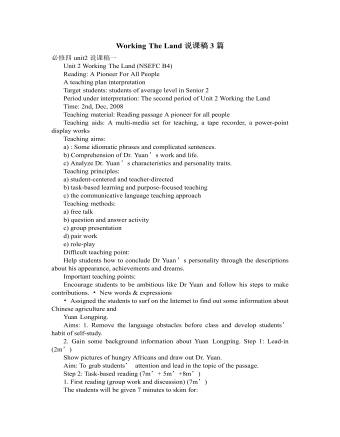
人教版高中英语必修4Working The Land说课稿3篇
Knowledge objectives:(1) to make Ss grasp the usage of words, expressions and sentence structures: statistics, struggle, thanks to, rid of, some patterns for persuasion, the “ing” form as subject and object;(2)to use learnt knowledge to persuade sb.Ability objectives:(1) to develop Ss’ reading skills(skimming, scanning, word guessing);(2) to improve Ss’ speaking, communicating and cooperating skills.Emotional objectives:to make Ss know the contribution of Yuan,and learn his spirit and his simple life time.Teaching important and difficult points:(1) some words, expressions and sentence structures mentioned above;(2)the content of the text;(3)training their reading and speaking skills.Teaching methods: CLT, TBLT,QT.Learning strategies: CLS, QLS, TBLS.Teaching procedures:Step 1 lead-in: (1) teacher plays a piece of recent news from CCTV about the harvest of the super hybrid rice, and ask students whether they know Yuan or not, and talk about him and his contribution.(2)Brain storm: let Ss describe Yuan in their minds including his appearance, his living condition and so on.Step 2 fast reading tasks:(1)teacher introduces Yuan and super hybrid rice(2)make Ss read the text as fast as possible with questions. Such as: what’s the general ideaof this passage? What’s Yuan’ dream? (skimming and scanning skill)Step 3 intensive reading tasks(1)let Ss read the text silently, find topic sentence of each paragraph and draw the difficult sentences and the knowledge what they don’t understand.(words guessing)(2)teacher and Ss talk about the important words, expressions and sentences together, and ask Ss to retell the content of the text.(summarizing and paraphrasing)(3)teacher summarize this part.(4) read again following the courseware.
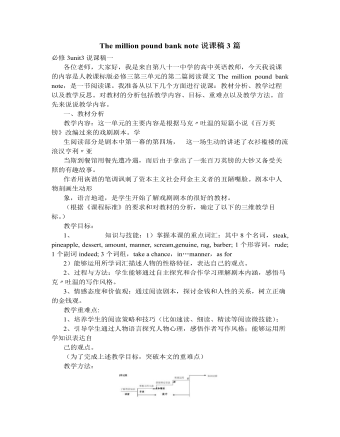
人教版高中英语必修3The million pound bank note说课稿3篇
在接下来的细读环节,我套用了高考对阅读理解的考查方式设置了5个问题,分别为三个推理判断题,一个细节题和一个主旨大意题。学生需要对文章的内容进行分析、归纳、推理、猜测等高级思维活动才能做出正确的回答。【设计意图】这一过程是对学生进行细读的训练,培养学生获取特定信息和挖掘文章深层次信息的能力。第三环节:Intensive-reading (精读) 15′第三个环节精读,既是最重要的环节,也是突破本课重难点的关键。首先,让学生思考剧本中人物看到百万英镑前后的态度发生了怎样的变化。其次,让学生仔细阅读文章,找出可以表现人物态度变化的具体的语言和动作。最后,让学生总结人物的态度发生变化的根本原因是什么,从而引出Money Talks, 供学生思考。【设计意图】通过一系列的活动培养学生学习从人物的语言和动作探究人物的心理,使学生进一步体会戏剧语言的魅力,从而对文章背后所反映的社会问题进行思考,也为下一步的讨论环节做好铺垫。
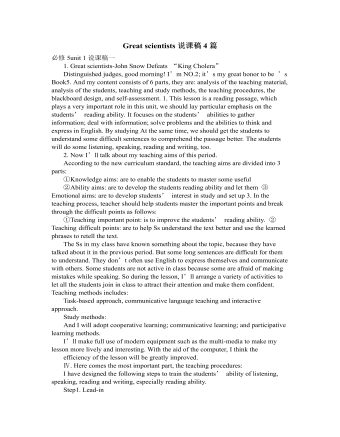
人教版高中英语必修5Great scientists说课稿4篇
通过写文章梗概,培养学生综合运用语言的能力,学习用恰当的英语描述科学家的故事。这是本课的教学难点。教师可以使用完形填空的方式来帮助学生整理语篇,从而来降低难度。本课的教学重点的突破方法是:在阅读前,让学生初步了解得出科学观点所需要的基本程序,从而轻松而自然地导入文章的阅读;在阅读过程中,由易到难设计快速阅读和精读的问题,层层推进各种阅读活动,让学生对阅读内容从整体感知到细节理解,最后深层读懂整篇文章,同时加强阅读策略的指导,让每个学生都主动参与课堂教学活动,最终达到提高阅读能力的目的。Step 4 Post-readingGroup Activities四人小组共同合作,在老师的适当指导下,就以下2个问题展开讨论,让学生就所知、所学、所感和所想融入话题,然后抽若干同学代表作小组发言。1. What do you think about John Snow, and what should we learn from him?2. Cholera was 19th century disease, which two diseases are similar to cholera today? Why?


